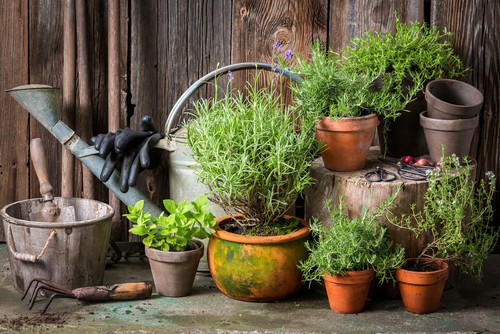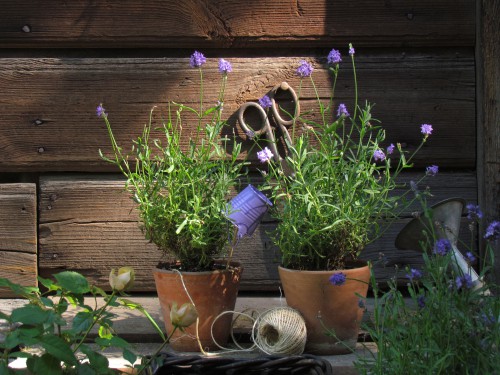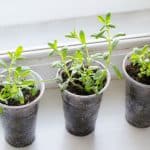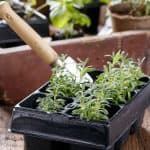Last updated on March 6th, 2022
Our site is reader supported, this means we may earn a small commission from Amazon and other affiliates when you buy through links on our site.
Lavender is a wonderful herb that offers beautiful purple flowers, heavy fragrance and invites bees and butterflies to your garden. It is incredibly popular when used in its dry form for different potpourri purposes or in sachets and it’s also perfect for cooking recipes too.
A native Mediterranean plant, there are plenty of environments where Lavender simply won’t thrive as effectively. In some cases, you might have soil that is simply too dense to support its growth or your winters are too cold, this is especially true for some varieties that are much more tender than others. In other cases, you might simply want to grow Lavender inside your home to enjoy year-round. In all of these situations, container growing is a perfect solution.
Growing Lavender in Pots
You can grow your Lavender in pots from seed, from cuttings or from pre-established plants that you have purchased from a nursery or garden centre. The latter is the most popular choice because it’s instant.

Sowing from seed
If you are planting seeds you want to place the seed on top of the compost and then lightly sprinkle compost on top, allowing the seed ample exposure to sunlight and the opportunity to propagate within the container. This process will take much longer than the other options and you’ll start to see the seedlings after about 2-3 weeks. Ideally, you should sow the seeds in a seed tray first, then transplant them to a smaller pot before potting on into their final pot. We did a whole article on how to grow Lavender from seeds here.
Growing Lavender from cuttings
If you already have a plant that you like, you can propagate additional plants from it by taking cuttings, which is much a faster process compared to sowing seeds. Just take a cutting from below a node, dip the cutting in a form of root hormone and then put them directly into a small container. Again this takes patience.
Pre-established plants
Finally, you can simply purchase pre-started plants from a nursery or garden centre and transplant them into a container of your choosing. This is by far the easiest way and most popular choice.
Choosing a Container
No matter the method you use it’s important that you pick an appropriately-sized container and the right type of potting compost. If, for example, you are growing from seed, you will want a seed starter soil initially. A layer of perlite is recommended to help growth for cuttings and seeds.

Lavender plants do not like to be damp but of course, they like to remain moist. To that end, you need to think about the drainage afforded by the containers you select. Not all the pots you purchase at a garden centre are going to have drainage effective enough, this is especially true for plastic pots that often don’t have pre-drilled holes.
You need to check the bottom of the container to see how many holes it has and possibly drill additional holes if necessary. If you are using a plastic container you can obviously drill directly into the container but don’t apply too much pressure because this can cause the bottom of the container to crack.
If you’re going to keep your container indoors you will need to purchase a saucer that goes underneath the container to catch any water. You don’t want a pot that has a saucer attached to the bottom because this can actually impede drainage and make it much more difficult for you to maintain the overall health and well-being of your Lavender.
Ideally, you need the final pot to be around 30-40cm wide.
Winter Protection
Lavender can be a bit tricky if it’s not given the right temperature, water or sun exposure. If you live in a very cold area you should bring your Lavender plants inside during the winter. They need to be kept somewhere they will receive full sun and full sun means at least 8 hours each day. If you keep them outside plan somewhere that they get full sun exposure. If you bring them inside for the winter or you keep them inside regularly, put them on a windowsill that gets full sunlight.
If you don’t want to bring them inside over winter you can choose to start over each year with seeds, cuttings or new plants. In general, though if you have a hardy variety such as Lavendula Munstead and you keep it in a sheltered spot overwinter outside and it should be just fine. Not all varieties are hardy so be sure to check when choosing a variety.
Be aware of how often you water so that the soil is allowed to dry out in between waterings but it doesn’t result in a wilting Lavender plant for any period of time. In winter we recommend only watering once the soil has become dry or the plant has just started to show signs of wilting.
Pruning
Lavender plants don’t tend to regrow from old wood and this means that you need to prune them correctly to stop them from getting woody, but incorrect pruning can effectively result in a poor plant.
Prune Lavender at the end of summer after flowering, you want to cut within 1-2 inches of the previous year’s growth. Never cut into the old wood. You can also prune in spring just as they start to get new growth and remove any damaged or diseased growth.
Doing all of these things regularly will provide you with a stunning and soothing plant all year round.


